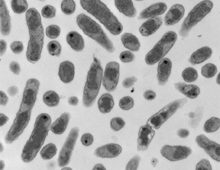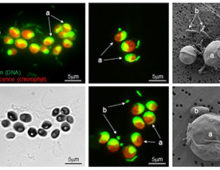We will use a high-throughput approach to help fill-in gaps in knowledge of the functional properties of microbes and their genes, laying a solid foundation for researchers hoping to engineer bacteria with improved or novel traits.
Most Abundant Diatom Genus in the World’s Ocean
Chaetoceros is the most abundant and cosmopolitan diatom genus in the world’s ocean, so these genomes will enable population genetics studies and allow exploration of the genetic and epigenetic contributions to species adaptation and evolution.
How Beneficial Fungi Regulate Effector Gene Expression
In this study, we will perform a fine-graded comparative analysis of transcription factor activities and functions in relation to beneficial fungal-associations with model plant hosts and measure how outcomes are altered by encounters with pathogenic fungi and selected root-associated bacteria. Improved knowledge of fungal gene regulation during confrontation with other microbes and in different plant hosts will help engineering more resilient fungal strains with enhanced root colonization and growth promotion capacities and provide fresh leads to plant-protection strategies.
Virus-Host Interactions in Model Systems
Microbes and their viruses are recently found to be profoundly impacting in virtually any ecosystem studied – from the oceans and soils to humans and bioreactors. While our knowledge of viral diversity is growing, we often observe genomes without knowing which host cell the virus infects. This proposal seeks to leverage ecosystem modeling and high-resolution time series datasets to scalably identify which viruses infect which hosts in experimental model systems and complex communities. Should it be successful, the new analytic will be powerful context for studying viruses in any ecosystem.
Microbial Genomes Across the World’s Rivers
This proposal seeks to create a global census of microbial genomes across 250 of the world’s rivers, from the Amazon to the Mississippi. Our goal is to create a Genome Resolved Open Watershed (GROW) database- which will be an open access resource to advance knowledge of aquatic microbiology for the entire scientific community.
Inter-organismal Interactions in the Rumen Ecosystem
We propose to generate data that would provide us with a better understanding of the role of different microorganisms involved methanogenesis in the rumen ecosystem and the foundation to develop new strategies for methane mitigation from ruminants. Ruminant animals are one of major anthropogenic sources of the highly potent greenhouse gas methane and advanced methane mitigation strategies would have a significant impact on the global methane emission and the therefore on climate change. This aligns fully with DOE’s mission to reduce the anthropogenic carbon footprint.
Diversity of Parasitic and Commensal Chytrids
Chytrids are basal fungi. Despite the chytrids major negative impact on algal phytoplankton productivity and as a major pest in microalgal biofuels production facilities, extremely little is known about the biology of these organisms. We expect that the genomic data provided from this CSP will shed light on the “blackbox” of unknown molecular events at various stages of infections in the inter-organismal chytrid/algal systems. This work is highly relevant to the DOE mission in the context of organic carbon cycling in aquatic plankton communities and due to the microalgae being feedstock for biofuels applications.
International Arctic Ice Drift Experiment MOSAiC
The MOSAiC drift experiment will provide sequence data to study for the first time how microbial communities change over a complete seasonal cycle in the Arctic Ocean in terms of their diversity and gene activity. These results will be instrumental to study climate processes they drive.
Cross-Domain Interactions in Microalgae Communities
We will characterize algal communities from some of the most productive ecosystems in the world to understand the interactions between the microbial community members involved. Our goal is to develop strategies for establishing stable and highly productive photosynthetic communities suitable for biofuel and high-value product generation on an industrial scale.
Characterizing Viruses in Antarctica
Characterizing viruses in extreme environments may facilitate a better understanding of the role that viruses play in the dynamics and evolution of complex microbial communities.

